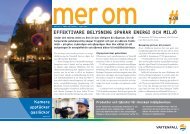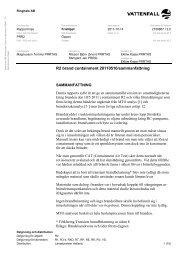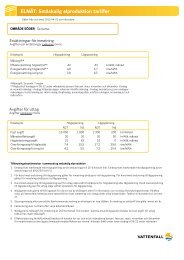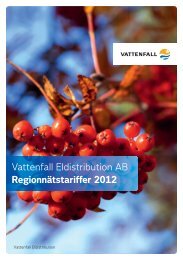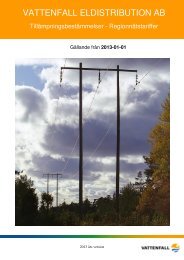This environmental impact assessment for Kriegers flak ... - Vattenfall
This environmental impact assessment for Kriegers flak ... - Vattenfall
This environmental impact assessment for Kriegers flak ... - Vattenfall
Create successful ePaper yourself
Turn your PDF publications into a flip-book with our unique Google optimized e-Paper software.
Direction of flights <strong>for</strong> land birds during individual months of the main flight<br />
Flyttriktning för landfågel under enskilda månader av huvudsträcket<br />
Direction and height distribution<br />
During spring migration the preferred<br />
ß ight direction was from north to east. The<br />
direction of ß ights <strong>for</strong> land and water fowl<br />
is presented in the tables below and on the<br />
previous page.<br />
During the visual observations nearly<br />
half of the birds ß ew below 10 meters<br />
height (Þ gure on the right).<br />
Generally, water fowl were ß ying at<br />
the lowest heights. Differences <strong>for</strong> both<br />
season and species were noted (Þ gure on<br />
the right).<br />
Birds were ß ying at a higher levels<br />
during spring than during autumn. Geese,<br />
wigeons and cranes ß ew higher than 50<br />
metres. Gulls, apart from little gulls,<br />
ß ew at a level of 10-50 metres. Loons and<br />
pochards, particularly eider ducks and<br />
scoters ß ew below 10 metres.<br />
The ß ight of cranes on 27 March 2004<br />
took place at between 100 and 200 metres<br />
height. <strong>This</strong> differs from the ß ight of<br />
cranes between 12 and 13 September 2002,<br />
where the average ß ight height, with the<br />
aid of radar, was recorded to 242 metres.<br />
PRESENTATION OF THE AREA 95<br />
Month N NE E SE S SW W NW n<br />
April 2002 51 6 19 10 3 0 8 4 455<br />
March 2003 25 8 2 13 17 13 2 20 179<br />
April 2003 36 52 4 4 0 0 0 4 143<br />
May 2003 54 0 4 2 7 7 13 14 56<br />
March 2004 46 50 1 1 0 0 0 2 924<br />
August 2002 0 0 0 5 77 5 9 5 22<br />
September 2002 35 0 3 0 25 5 33 1 610<br />
October 2002 0 0 0 0 96 0 5 0 119<br />
July 2003 1 1 3 20 15 37 17 6 231<br />
August 2003 1 2 0 2 15 36 46 0 131<br />
September 2003 0 1 6 4 70 12 6 0 159<br />
October 2003 3 0 2 4 3 9 68 11 376<br />
Species/Group of species < 10 m 10–50 m > 50 m n groups<br />
Divers Gavia spec. 50/29 25/57 25/14 16/14<br />
Cormorant Phalacrocorax<br />
carbo 37/46 50/42 13/12 30/41<br />
Barnacle goose Branta<br />
leucopsis 75/35 8/8 17/57 12/40<br />
Geese Anser spec., Branta spec. 13/51 27/26 60/23 15/74<br />
Wigeon Anas penelope 35/47 21/47 45/6 29/19<br />
Eider Somateria mollissima 64/53 25/45 12/2 52/617<br />
Common scooter Melanitta<br />
nigra 47/70 37/28 17/2 60/74<br />
Long-tailed duck Clangula<br />
hyemalis 93/100 8/0 0/0 14/12<br />
Sparrow hawk Accipiter nisus 30/65 40/35 30/0 10/26<br />
Crane Grus grus 5/0 11/8 84/92 19/12<br />
Herring gull Larus argentatus 12/33 82/50 6/17 138/12<br />
Lesser black-backed gull Larus<br />
fuscus 21/41 79/59 0/0 19/22<br />
Common gull Larus canus 30/22 70/78 0/0 10/18<br />
Common gull Larus minutus 67/77 33/23 0/0 18/57<br />
Barn swallow Hirundo rustica 65/60 29/38 6/2 17/52<br />
Pied wagtail Motacilla alba 57/77 38/23 4/0 47/13<br />
Meadow pipit Anthus pratensis 26/83 62/12 13/5 47/41<br />
Chaffi nch Fringilla coelebs 31/60 54/40 15/0 13/10<br />
Percentage distribution of flight heights <strong>for</strong> migrating birds at<br />
<strong>Kriegers</strong> Flak according to visual observations during the first<br />
and second year of survey (n = number of groups).





